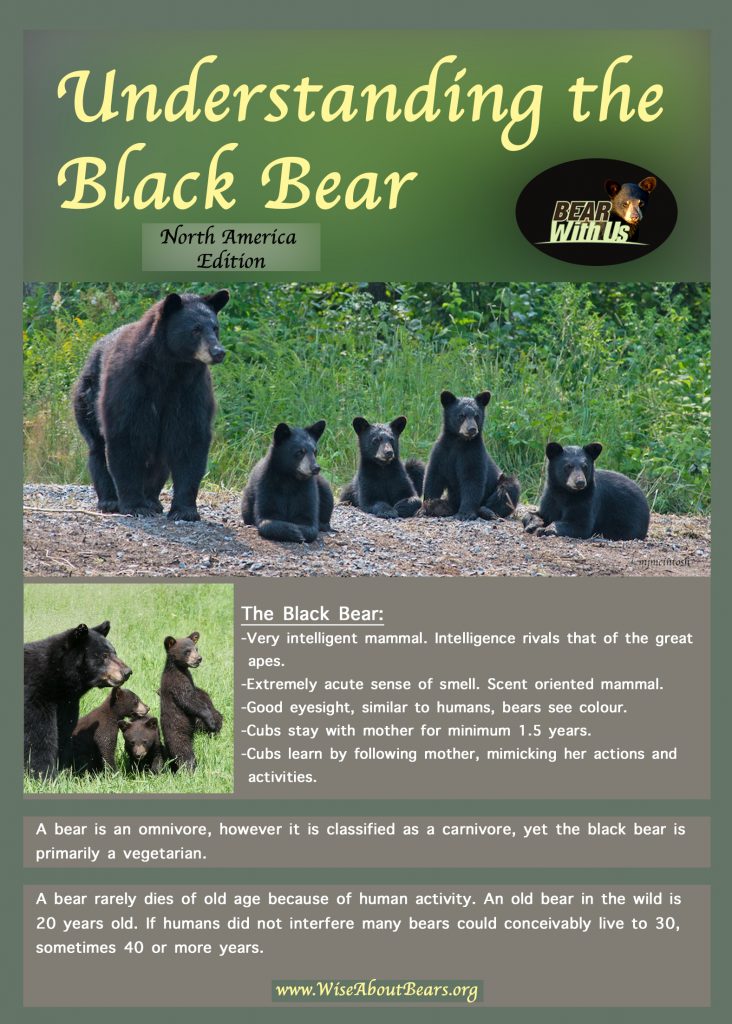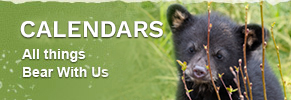

Colour: Body fur black, brown, blonde, or rarely white. Brown muzzle. White chest patch on some not all, always unique. Eyes brown (blue at birth). Skin light coloured.
Adult Weight:
Males: up to 500 pounds common, depending upon age, season, and food. Record: 816 pounds; Minnesota, over 800 pounds recorded in Manitoba;
Females: 90 to 300 pounds common. Record: 454 pounds; Pennsylvania. Mike McIntosh of Bear With Us relocated a 360 pound female in the fall of 1998 in Central Ontario. Captive bears may exceed these records.
Adult Length: 50 to 80 inches, nose to tail, depending on sex.
Litter Size: Typically 2 in the West, 3 in the East. First litters often 1 or 2. Record: 6, Pennsylvania.
Mating Season: Late May to July. Occasionally longer.
Birth Month: January.
Birth Weight: 1/2 pound.
Weight at 1 Year: 15 pounds to more than 100 pounds, depending on food supply.
Parental Care: 17 months (rarely 29 months), ending in June/July when mothers become ready to mate again.
Age at Production of First Cubs: 4 to 9 years(Ontario), depending upon food supply.
Interval Between Litters: 2 to 4 years, most often 2 years, depending upon food supply.
Sex Ratio: Nearly even at birth, generally with a bias toward males.
Vision: Color vision. Good near vision. Untested distance vision, vision appears to equal humans.
Hearing: Exceeds human frequency ranges and sensitivity.
Smelling: One hundred times more nasal mucosa than a human. Smelling ability is extremely good. The limits of this sense have not been tested.
Intelligence: One of the most intelligent mammals. Can generalize to the simple concept level. Long-term memory excellent. Heaviest brain, relative to body length, of any land carnivore.
Sounds: Grunts, loud blowing, and a resonant “voice”. Does not threaten by growling.
Swimming Distance: excellent long distance swimmer. May swim to island campsites.
Running Speed: Lean bears may exceed 30 mph. Can run uphill or downhill. Fat bears in winter readiness tire and overheat quickly.
Daily Activity Period: Typically 1/2 hour before sunrise to 1 to 2 hours after sunset. Prefer to be active during daylight hours, however may become nocturnal to avoid people.
Home Range Diameter:
Yearlings: 1-2 miles.
Adult females: 2-6 miles. Adult males: 8-15 miles.
Preferred Foods: Fruit, nuts, acorns, insects, succulent greens, and meat. Less preferred foods may cause weight loss.
Hibernation: 0 to 7 months depending upon food supply.
Potential Longevity: 21-33 years and more. Oldest wild bear recorded shot at age 41 years, New York State – 1974
Causes of Death: Bears 2 years old or older outside national parks: 95 percent gunshot; 5 percent natural causes, road-kill, and other human-related causes. Average age of death from human-related causes: 6 years (northeastern Minnesota). Cubs and yearlings; starvation, predation, falls from trees, road-kills, etc. Few bears die of disease.
Range: Extensive forests with low human populations from Florida and Mexico to Alaska and Labrador, extending onto open tundra where grizzly bears have been extirpated in northern Labrador.
Optimum Habitat: Extensive forests with a variety of fruit- and nut-producing species. Small openings promote fruiting of many shrub species. Lowlands and wetlands are important sources of succulent vegetation. Streams and pools are needed for drinking and cooling. trees larger than 20 inches d.b.h. with strong, furrowed bark are easily climbed refuges for spring cubs.
Long-Term Problem: Human population expansion is reducing bear habitat. Human tolerance of black bars is low due to unrealistically ferocious popular image of black bears.

Credits: University of Minnesota, Dr. Lynn Rogers for text. Brochure at top of page and photos – Mike and Ella McIntosh


